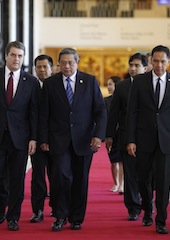Small Business and the WTO
Why small businesses are likely to benefit from the WTO’s new agreement.
December 16, 2013

The WTO’s new “Trade Facilitation” agreement, completed on December 6th at the group’s Ministerial Conference in Bali, is a very practical accord, likely to be especially useful to small businesses. Below are three perspectives on the deal:
1. Legal reforms
In a legal sense, it is 27 pages of text stocked with requirements for customs and inspection agencies. Main features include:
- required publication of regulations and fees
- appeal-and-comment rights when new regulations are introduced
- mandatory Internet availability of documents and payment options
- special procedures for expedited release of air cargo and perishable goods
- transit guarantees for cargoes from land-locked countries through neighboring countries to seaports without special fees
- and technical help for low-income countries in putting reforms of these sorts into place.
2. A WTO milestone
In diplomatic terms, the agreement is something of a milestone for the WTO. It is:
- The first WTO agreement of any sort since 1998, ending the longest gap between trade agreements since the Second World War.
- The first fully ‘multilateral’ agreement apply to all member states since the WTO’s creation in 1995. The three previous WTO agreements, respectively covering information technology tariffs, basic telecommunications services, and financial services, were done between 1996 and 1998 and apply to about 80 members each.
- The most widely applied trade agreement ever, with today’s 160 WTO members (counting new member Yemen) home to 93% of world population and the origin of 97.5% of world exports.
3. Growth value
“Macro” estimates of the value of trade facilitation are startlingly large. For example, a computer model done by the World Bank and World Economic Reform last spring found that bringing countries halfway to ‘best practices’ in trade facilitation would add 4.7% to world GDP, which is nearly six times the estimate for full tariff elimination.
These practices include improved telecommunications and road transport, as well as the customs and regulatory-transparency issues covered in the agreement.
Much of the anticipated growth should come from small businesses. Technological advance is already encouraging them to export, as search engines and on-line market places make it cheaper to find overseas customers, and express delivery services make small deliveries faster and cheaper.
Small businesses in a globalized economy
Worldwide, a survey by Geneva’s International Trade found 55% of small-business respondents agreeing that it is steadily easier for them to export. The 2012 Online Marketplace report from eBay found 97% of the auction site’s commercial sellers exporting.
In the United States, annual reports by the Bureau of Economic Analysis finds net gain of about 2,000 very small exporting businesses (with fewer than 20 employees) a year over the last decade, and 3,500 a year since the financial crisis.
Even with friendlier technologies and shippers, though, smaller businesses still have less time and money to devote to finding forms, puzzling out unpublished regulations, and dealing with shipment holds and rejections than do their larger cousins.
Thus they continue to find trade more expensive than do larger firms with overseas offices and legal staff, and their share of exports remains relatively small.
The agreement’s main provisions – ensuring simple and clear access to overseas documents and regulations, encouraging express delivery and air cargo, and requiring clear procedures for cargo holdups and releases – are likely to help them most.
Takeaways
The WTO’s new “Trade Facilitation” agreement from Bali is a very practical accord.
The new WTO deal is likely to be especially useful to small businesses around the world.
The Bali deal is the first WTO agreement since 1998, ending the longest gap between trade agreements since WWII.
‘Best practices’ in trade facilitation would add 4.7% to world GDP, or nearly 6x more than full tariff elimination.
Even with friendlier technologies and shippers, smaller businesses still struggle to navigate customs.
Clearer and easier customs and shipping procedures between countries will help small businesses export more.

